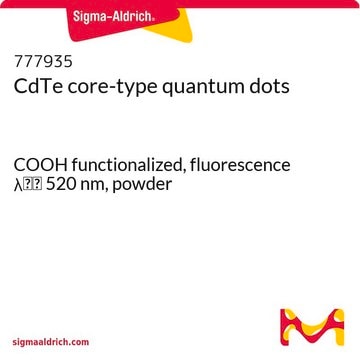95199
Fluorescent Dopamine Neurotransmitter Ligand, labeled with Dansyl
suitable for fluorescence, ≥98% (HPLC)
Sinónimos:
Dansyl-C5-Dopamine
Iniciar sesiónpara Ver la Fijación de precios por contrato y de la organización
About This Item
Código UNSPSC:
12352116
NACRES:
NA.32
Productos recomendados
Análisis
≥98% (HPLC)
formulario
solid
fluorescencia
λex 333 nm; λem 515 nm±5 nm in DMSO
idoneidad
suitable for fluorescence
temp. de almacenamiento
2-8°C
Descripción general
This fluorescent labeled catecholamine neurotransmitter analog of dopamine (Product Name: DnsylD-1), with dansyl attached by a 5-carbon spacer arm to dopamine, provides a unique pharmacological tool. DnsylD-1 is a stable, receptor selective and high affinity pharmacological ligand that can be detected by fluorescent microscopy and FLIPR devices. Unlike recently reported synthesized fluorescent neurotransmitter analogs, DnsylD-1 contains the entire native dopamine structural moiety attached with the 5-carbon polylinker to the small fluorescence label dansyl. This structural modification minimizes steric hindrance, making DnsylD-1 an effective reagent for dopamine ligand binding and transporter uptake assays at namomolar concentrations.
A large stokes shift between excitation and emission maxima (Ex:Em, 313:515 nm) of DnsylD-1 provides high signal to noise detection with minimal autofluorescence. The dansyl moiety also changes spectral characteristics on intermolecular contact, facilitating biophysical characterization of ligand-receptor interaction. DnsylD-1 is a suitable substitute for radioactive ligand.
A large stokes shift between excitation and emission maxima (Ex:Em, 313:515 nm) of DnsylD-1 provides high signal to noise detection with minimal autofluorescence. The dansyl moiety also changes spectral characteristics on intermolecular contact, facilitating biophysical characterization of ligand-receptor interaction. DnsylD-1 is a suitable substitute for radioactive ligand.
Aplicación
Applications for Fluorescent Dopamine Ligand-Neurotransmitter (DnsylD-1)
DnsylD-1 has the following applicability due to the small molecular size of the dansyl fluorescent label, a long spacer arm between the dopamine structure and the fluorescent tag, stability in aqueous solution and low autofluorescence of the surrounding cellular or tissue medium.
DnsylD-1 has the following applicability due to the small molecular size of the dansyl fluorescent label, a long spacer arm between the dopamine structure and the fluorescent tag, stability in aqueous solution and low autofluorescence of the surrounding cellular or tissue medium.
- Histochemical imaging and quantitation of dopamine receptor expression in vivo and vitro.
- Pharmacological applications as a substitute for radioactive ligand.
- Dopamine metabolism and turnover analysis.
- Dopamine uptake analysis.
- Dopaminergic neuron detection.
- Analysis of disease conditions associated with altered dopamine synthesis, dopamine receptor expression or dopamine uptake: human disease research applicability in the following: a) Parkinson′s disease. b) Psychological disorder, including ADHD, schizophrenia and substance abuse. c) Physiological regulation of cardiovascular, renal and immune function.
Características y beneficios
Highlights
- Dansyl labeled dopamine that operates selectively in binding and uptake assays at nanomolar concentrations.
- The native dopamine chemical structure is the major component of this fluorescent labeled catecholamine, which generates a fluorescent neurotransmitter molecule with high affinity toward all dopamine receptor subtypes, as well as to the dopamine transporter.
- The small dansyl tag with a 5-carbon polylinker to dopamine generates a stable, bright fluorescent signal with negligible steric hindrance.
- The dansyl fluorescent tag creates a large stokes shift minimizing autofluorescence and non-specific background signal.
- The fluorescent signal of DnsylD-1 is blockable by standard inhibitors to dopamine receptors and DAT.
- Standard inhibitors can also be employed to distinguish the interaction of DnsylD-1 with dopamine receptors and DAT.
- Fluorescence from DnsylD-1olocalizes with tyrosine hydroxylase thereby identifying dopaminergic neurons.
- To assay for dopamine receptor binding, first suspend the provided solid in DMSO (10 - 50 μl). Centrifuge and then dilute an aliquot of the supernatant into your assay buffer (for example PBS-BSA) to the desired assay concentration. DnsylD-1 when suspended in DMSO and frozen at -20oC is stable for at least 2 years. Detect DnsylD-1 by fluorescent microscopy, with a fluorescent plate reader or by flow cytometry. Set the fluorescent detection device to the following parameters: Ex/Em: 333/515 nm.
Otras notas
Proprietary product of Fivephoton Biochemicals
Código de clase de almacenamiento
11 - Combustible Solids
Clase de riesgo para el agua (WGK)
WGK 3
Punto de inflamabilidad (°F)
Not applicable
Punto de inflamabilidad (°C)
Not applicable
Certificados de análisis (COA)
Busque Certificados de análisis (COA) introduciendo el número de lote del producto. Los números de lote se encuentran en la etiqueta del producto después de las palabras «Lot» o «Batch»
¿Ya tiene este producto?
Encuentre la documentación para los productos que ha comprado recientemente en la Biblioteca de documentos.
Nuestro equipo de científicos tiene experiencia en todas las áreas de investigación: Ciencias de la vida, Ciencia de los materiales, Síntesis química, Cromatografía, Analítica y muchas otras.
Póngase en contacto con el Servicio técnico







